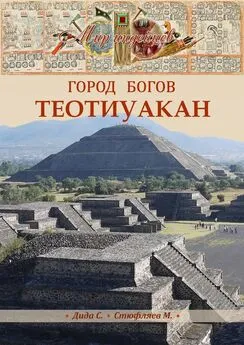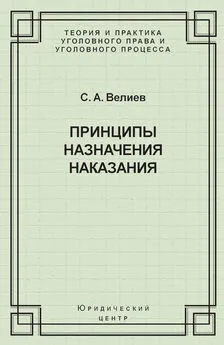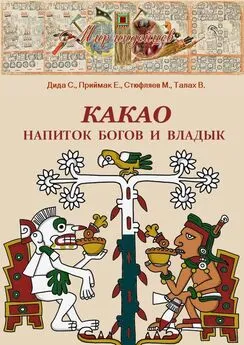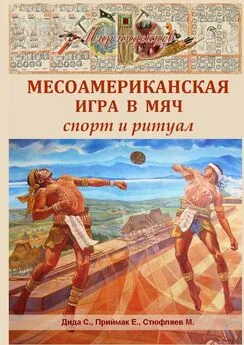Самир Дида - Теотиуакан
- Название:Теотиуакан
- Автор:
- Жанр:
- Издательство:неизвестно
- Год:16
- ISBN:нет данных
- Рейтинг:
- Избранное:Добавить в избранное
-
Отзывы:
-
Ваша оценка:
Самир Дида - Теотиуакан краткое содержание
Предисловие: В. Талах
На обложке: пирамида Солнца, фото Дм. Иванова
Теотиуакан - читать онлайн бесплатно ознакомительный отрывок
Интервал:
Закладка:
Looper M. Lightning Warrior: Maya Art and Kingship at Quirigua. — Austin: University of Texas Press, 2003. — 277 p.
Looper M., Polyukhovych Y. A Familial Relationship Between Nobles of El Peru (Waka’) and El Zotz (Pa’chan) as Recorded on a Polychrome Vessel // Glyph Dwellers, Report 47, 2016. P. 1—11.
López Luján L., Filloy Nadal L., Fash B. et al. The Destruction of Images in Teotihuacan: Anthropomorphic Sculpture, Elite Cults, and the End of a Civilization // RES: Anthropology and Aesthetics. — 2006. — No. 49/50. — P. 12—39.
Manzanilla L.R. Teotihuacán: Underworld Study // FAMSI Reports, 1996. URL: http://www.famsi.org/reports/95007/
Manzanilla L.R. Corporate Groups and Domestic Activities at Teotihuacan // Latin American Antiquity. — 1996. — Vol. 7, N. 3. — P. 228—246.
Manzanilla L.R. The Emergence of Complex Urban Societies in Central Mexico: The Case of Teotihuacan // Archaeology in Latin America / Ed. by G.G. Politis and B. Alberti. — London and New York: Routledge, 1999. — P. 93—129.
Manzanilla L.R. The Construction of the Underworld in Central Mexico: Transformations from the Classic to the Postclassic // Mesoamerica’s Classic Heritage: From Teotihuacan to the Aztecs / Ed. by D. Carrasco, L. Jones, and S. Sessions. — Boulder: University Press of Colorado, 2000. — P. 87—116.
Manzanilla L.R. Houses and Ancestors, Altars and Relics: Mortuary Patterns at Teotihuacan, Central Mexico // Archaeological Papers of the American Anthropological Association, — Vol. 11, Issue 1: The Space and Place of Death / Ed. by H. Silverman and D. B. Small, 2002. — P. 55—65.
Manzanilla L.R. Living with the Ancestors and Offering to the Gods: Domestic Ritual at Teotihuacan // Domestic Ritual in Ancient Mesoamerica / Ed. by P. Plunket. — Los Angeles: University of California, 2002. — P. 43—52.
Manzanilla L.R. The Abandonment of Teotihuacan // The Archaeology of Settlement Abandonment in Middle America / Ed. by T. Inomata and R.W. Webb. — Salt Lake City: The University of Utah Press, 2003. — P. 91—101.
Manzanilla L.R. Corporate Life in Apartment and Barrio Compounds at Teotihuacan, Central Mexico: Craft Specialization, Hierarchy and Ethnicity // Domestic Life in Prehispanic Capitals: A Study of Specialization, Hierarchy and Ethnicity / Ed. by Manzanilla L.R, Chapdelaine C. — Ann Arbor: University of Michigan Museum, 2009. — P. 21—42.
Manzanilla L.R. Cooperation and Tensions in Multiethnic Corporate Societies Using Teotihuacan, Central Mexico, as a Case Study // Proceedings of the National Academy of Sciences. — 2015. — Vol. 112, N. 30. — P. 9210—9215.
Manzanilla L.R. Teotihuacan, ciudad excepcional de Mesoamerica. — Mexico: El Colegio Nacional, 2017. — 144 p.
Manzanilla L.R., Bokhimi X., Tenorio D. et al. Procedencia de la mica de Teotihuacan: control de los recursos suntuarios foráneos por las élites gobernantes // Anales de Antropología. — 2017. — Vol. 51, Issue 1. — P. 23—38.
Manzanilla L.R., Carreón E. A Teotihuacan Censer in a Residential Context: An Interpretation // Ancient Mesoamerica. — 1991. — Vol. 2, N. 2. — P. 299—307.
Manzanilla L.R., López C., Freter A. Dating Results From Excavations in Quarry Tunnels Behind the Pyramid of the Sun at Teotihuacan // Ancient Mesoamerica. — 1996. — Vol. 7, N. 2. — P. 245—266.
Marcus J., Flannery K. Zapotec Civilization: How Urban Society Evolved. — London and New York: Thames and Hudson, 1996. — 255 p.
Martin S. At the Periphery: The Movement, Modification and Re-Use of Early Monuments in the Environs of Tikal // The Sacred and the Profane: Architecture and Identity in the Maya Lowlands / Ed. by P. R. Colas, K. Delvendahl, M. Kuhnert, A. Schubart. Acta Mesoamericana, Vol. 10. — Markt Schwaben, Verlag Anton Saurwein, 2000. — P.51—62.
Martin S. The Power in the West — the Maya and Teotihuacan // Maya: Divine Kings of the Rain Forest / Ed. by N. Grube. — Köln: Könemann Verlagsgesellschaft, 2001. — P. 99—111.
Martin S. In Line of the Founder: A View of Dynastic Politics at Tikal // Tikal: Dynasties, Foreigners, and Affairs of State / Ed. by J. A. Sabloff. — Santa Fe — Oxford: School of American Research Press, 2003. — P. 3—45.
Martin S., Grube N. Chronicle of the Maya Kings and Queens: Deciphering the Dynasties of the Ancient Maya. 2nd edition. — London and New York: Thames and Hudson, 2008. — 240 p.
McCafferty G.G. Tollan Cholollan and the Legacy of Ligitimacy during the Classic-Postclassic Transition // Mesoamerica’s Classic Heritage: From Teotihuacan to the Aztecs / Ed. by D. Carrasco, L. Jones, and S. Sessions. — Boulder: University Press of Colorado, 2000. — P. 341—367.
Miller A. The Mural Painting of Teotihuacan. — Washington D.C.: Dumbarton Oaks, 1973. — 193 p.
Millon R. Urbanization at Teotihuacan, Mexico. Volume 1: The Teotihuacan Map. — Austin: University of Texas Press, 1973. — 154 p.
Moctezuma E.M. From Teotihuacan to Tenochtitlan: Their Great Temples // Mesoamerica’s Classic Heritage: From Teotihuacan to the Aztecs / Ed. by D. Carrasco, L. Jones, and S. Sessions. — Boulder: University Press of Colorado, 2000. — P. 185—194.
Moholy-Nagy H. Mexican Obsidian at Tikal, Guatemala // Latin American Antiquity. — 1999. — Vol. 10, No. 3. — P. 300—313.
Münch Galindo G. El cacicazgo de San Juan Teotihuacán durante la colonia, 1521—1821. — México: SEP Instituto Nacional de Antropología e Historia, Centro de Investigaciones Superiores, 1976. — 80 p.
Murakami T. Replicative Construction Experiments at Teotihuacan, Mexico: Assessing the Duration and Timing of Monumental Construction // Journal of Field Archaeology. — 2015. — Vol. 40, N. 3. — P. 263—282.
Murakami T. Entangled Political Strategies: Rulership, Bureaucracy, and Intermediate Elites at Teotihuacan // Political Strategies in Pre-Columbian Mesoamerica / Ed. by S. Kurnick and J. Baron. — Boulder: University Press of Colorado, 2016. — P. 153—180.
Nelson Z. Obsidian Biface Production at Teotihuacan: Reexamining a Coyotlatelco Phase Workshop from Hacienda Metepec // Ancient Mesoamerica. — 2009. — Vol. 20, N. 1. — P. 149—162.
Nichols D.L. Teotihuacan // Journal of Archaeological Research. — 2016. — Vol. 24, N. 1. — P. 1—74.
Nichols D.L., Spence M.W., Borland M.D. Watering the Fields of Teotihuacan: Early Irrigation at the Ancient City // Ancient Mesoamerica. — 1991. — Vol. 2, N. 1. — P. 119—129.
Nielsen J., Helmke C. Spearthrower Owl Hill: A Toponym at Atetelco, Teotihuacan // Latin American Antiquity. — 2008. — Vol. 19, N. 4. — P. 459—474.
Nielsen J., Helmke C. House of the Serpent Mat, House of Fire: The Names of Buildings in Teotihuacan Writing // Contributions in New World Archaeology. — 2014. — Vol. 7. — P. 113—139.
Nielsen J., Helmke C. «Where the Sun Came into Being»: Rites of Pyrolatry, Transition and Transformation in Early Classic Teotihuacan // Smoke, Flames, and the Human Body / Ed. by V. Tiesler and A. Scherer. — Washington D.C.: Dumbarton Oaks, 2018. — P. 77—107.
Parry W.J. Reflections on Reflections // Obsidian Reflections: Symbolic Dimensions of Obsidian in Mesoamerica / Ed. by M.N. Levine and D.M. Carballo. — Boulder: University Press of Colorado, 2014. — P. 279—318.
Parsons J.R. Teotihuacan, Mexico, and Its Impact on Regional Demography // Science. — 1968. — Vol. 162, N. 3856. — P. 872—877.
Paulinyi Z. The «Great Goddess» of Teotihuacan: Fiction or Reality? // Ancient Mesoamerica. — 2006. — Vol. 17, N. 1. — P. 1—15.
Paulinyi Z. The Maize Goddess in the Teotihuacan Pantheon // Mexicon. — 2013. — Vol. XXXV, Nr. 4. — P. 86—90.
Paulinyi Z. The Butterfly Bird God and his Myth at Teotihuacan // Ancient Mesoamerica. — 2014. — Vol. 25, N. 1. — P. 29—48.
Pecci A., Miriello D., Barca D. et al. Identifying a Technological Style in the Making of Lime Plasters at Teopancazco (Teotihuacan, México) // Archaeological and Anthropological Sciences. — 2018. — Vol. 10, Issue 2. — P. 315—335.
Prager C. A Classic Maya Ceramic Vessel from the Calakmul Region in the Museum Zu Allerheiligen, Schaffhausen, Switzerland // Human Mosaic. — 2004. — Vol. 35. — P. 31—40.
Prager C., Wagner E. A Possible Hieroglyphic Reference to Yax K’uk’ Mo’ at Caracol, Belize // Mexicon. — 2013. — Vol. XXXV, Nr. 2. — P. 31—32.
Prager C., Wagner E. Historical Implications of the Early Classic Hieroglyphic Text CPN 3033 on the Sculptured Step of Structure 10L 11-Sub-12 at Copan // Textdatenbank und Wörterbuch des Klassischen Maya, Research Note 7. Published 31 Aug 2017. — P. 1—27.
Price T. D., Manzanilla L., Middleton W. D. Immigration and the Ancient City of Teotihuacan in Mexico: A Study Using Strontium Isotopes Ratios in Human Bone and Teeth // Journal of Archaeological Science. — 2000. — Vol. 27. — P. 903—913.
Robb M.H. The Spatial Logic of Zacuala, Teotihuacán // Proceedings 6th International Space Syntax Symposium / Ed. by A. S. Kubat, Ö. Ertekin, Y. İ. Guney, E. Eyuboglu. — Istanbul: Istanbul Technical University Faculty of Architecture, 2007. — P. 062—01 — 062—16.
Robertson I. Investigating Teotihuacan through TMP Surface Collections and Observations // Ancient Mesoamerica. — 2015. — Vol. 26, N. 1. — P. 163—181.
Rubio J. D. Albañiles invisibles. Una aproximación al estudio del patrón de fosas de La Ventilla, Teotihuacan // Arqueología de la Arquitectura. — 2017. — N. 14, e052. — P. 1—12.
Ruvalcaba-Sil J. L., Manzanilla L., Melgar E. et al. PIXE and Ionoluminescence for Mesoamerican Jadeite Characterization // X-Ray Spectrom . — 2008. — Vol. 37. — P. 96—99.
Safronov A., Beliaev D. La epigrafía de Uaxactun despues de un siglo, 1916—2016 // XXX Simposio de Investigaciones Arqueológicas en Guatemala, 2016 / Editado por B. Arroyo, L. Mendez y G. Aju. — Guatemala: Museo Nacional de Arqueología y Etnología, 2017. — P. 515—528.
Schele L., Fahsen F., Grube N. El Zapote and the Dynasty of Tikal // Texas Notes on Precolumbian Art, Writing, and Culture, 34. Austin, 1992 — P. 1—11.
Schele L., Freidel D. A Forest of Kings: The Untold Story of the Ancient Maya. — New York: William Morrow Paperbacks, 1990. — 544 p.
Sharer R. Founding Events and Teotihuacan Connections at Copán, Honduras // The Maya and Teotihuacan, Reinterpreting Early Classic Interaction / Ed. by G. Braswell. — Austin: University of Texas Press, 2003. — P. 143—165.
Smith M.E. The Teotihuacan Anomaly: The Historical Trajectory of Urban Design in Ancient Central Mexico // Open Archaeology. — 2017. — Vol. 3, Issue 1. — P. 175—193.
Smith M.E., Dennehy T., Kamp-Whittaker A. et al. Quantitative Measures of Wealth Inequality in Ancient Central Mexican Communities // Advances in Archaeological Practice. — 2014. — Vol. 2, N. 4. — P. 311—323.
Smith M.E., Montiel L.M. The Archaeological Study of Empires and Imperialism in Pre-Hispanic Central Mexico // Journal of Anthropological Archaeology. — 2001. — Vol. 20, N. 3. — P. 245—284.
Spence M.W., Pereira G. The Human Skeletal Remains of the Moon Pyramid // Ancient Mesoamerica. — 2007. — Vol. 18, N. 1. — P. 147—157.
Spence M.W., White C.D., Rattray E.C. et al. Past Lives in Different Places: The Origins and Relationships of Teotihuacan’s Foreign Residents // Early Civilizations, Settlement and Subsistence: Essays in Honor of Jeffrey R. Parsons / Ed. by R.E. Blanton. — Los Angeles: Cotsen Institute, UCLA, 2005. — P. 155—197.
Šprajc I. Astronomical Alignments at Teotihuacan, Mexico // Latin American Antiquity. — 2000. — Vol. 11, N. 4. — P. 403—415.
Читать дальшеИнтервал:
Закладка:










